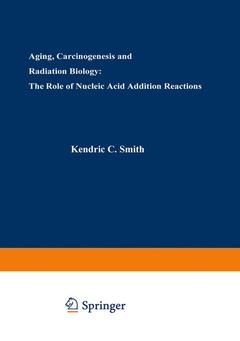Description
Aging, Carcinogenesis, and Radiation Biology, Softcover reprint of the original 1st ed. 1976
The Role of Nucleic Acid Addition Reactions
Coordinator: Smith Kendric
Language: English
Subject for Aging, Carcinogenesis, and Radiation Biology:
Keywords
Publication date: 01-2013
561 p. · 17.8x25.4 cm · Paperback
561 p. · 17.8x25.4 cm · Paperback
Description
/li>Contents
/li>
The covalent attachment to deoxyribonucleic acid in vivo of a large number of different types of chemical compounds (both normal cellular constituents such as proteins and amino acids, and also exogenous compounds such as drugs, carcinogens, etc. ) have been shown to exert profound effects upon cells. Four research activi ties, formerly considered to be totally independent, relate to this problem of nucleic acid adducts--(1) normal covalent attachment of DNA to membranes, protein linkers in chromosomes, etc. ; (2) the roles of radiation and chemical enhancement of DNA adduct formation in cell killing and mutagenesis. (A related field is the use of known cross-linking reactions to gain information on structural associations in macromolecular complexes. ); (3) the relevance of DNA adducts to chemical and radiation carcinogenesis; (4) the rele vance of DNA adducts to the cross-linking theory of cellular aging. (1) There are numerous examples of normal linkages between DNA and protein, e. g. , DNA-membrane attachment sites, protein linkers in chromosomes, amino acids covalently linked to DNA as a function of growth conditions, and gene regulation by non-covalently bound proteins. A summary of data on natural adducts to DNA thus serves to introduce the subject of the radiation and chemical enhancement of DNA adduct formation. (2) In the past, radiation biology has been concerned mainly with trying to understand the radiation chemistry of purified DNA, and the biological effects and repair of these radiation-induced alterations when produced in cellular DNA.
I. Natural Nucleic Acid-Protein Adducts.- Attachment of Chromosomes to Membranes in Bacteria and Animal Cells.- Linkers in Mammalian Chromosomal DNA.- Amino Acids Bound to DNA.- Gene Regulation: Selective Control of DNA Helix Openings.- II. Experimentally-Induced Nucleic Acid Adducts.- Radiation-Induced Cross-Linking of DNA and Protein in Bacteria.- UV-Induced DNA to Protein Cross-Linking in Mammalian Cells.- Role of Protein in the Inactivation of Viruses by Ultraviolet Radiation.- In Vitro Studies of Photochemically Cross-Linked Protein-Nucleic Acid Complexes. Determination of Cross-Linked Regions and Structural Relationships in Specific Complexes.- Photosensitized Cross-Linking of Proteins to Nucleic Acids.- Ionizing Radiation-Induced DNA-Protein Cross-Linking.- Chemically Induced DNA-Protein Cross-Links.- Photochemical Addition of Amino Acids and Related Compounds to Nucleic Acid Constituents.- Addition of Amino Acids and Related Substances to Nucleic Acids by Nucleophilic Catalysis.- Photochemically-Induced Adducts of DNA.- Ionizing Radiation-Induced Attachment Reactions of Nucleic Acids and Their Components.- Repair of DNA Adducts Produced by Alkylation.- Photoaffinity Labeling of Proteins and More Complex Receptors.- III. Relevance of DNA Adducts to Cancer Biology.- Chemically and Metabolically Induced DNA Adducts: Relationship to Chemical Carcinogenesis.- Involvement of Radicals in Chemical Carcinogenesis.- Role of DNA Repair in Mutation and Cancer Production.- IV. Relevance of DNA Adducts to Aging.- Cross-Linkage Hypothesis of Aging: DNA Adducts in Chromatin as a Primary Aging Process.- Dose, Dose Rate, Radiation Quality, and Host Factors for Radiation-Induced Life Shortening.- Protection of Environmentally Stressed Human Cells in Culture with the Free Radical Scavenger, dl-?-Tocopherol.- Role of DNA Repair in Aging.
© 2024 LAVOISIER S.A.S.

